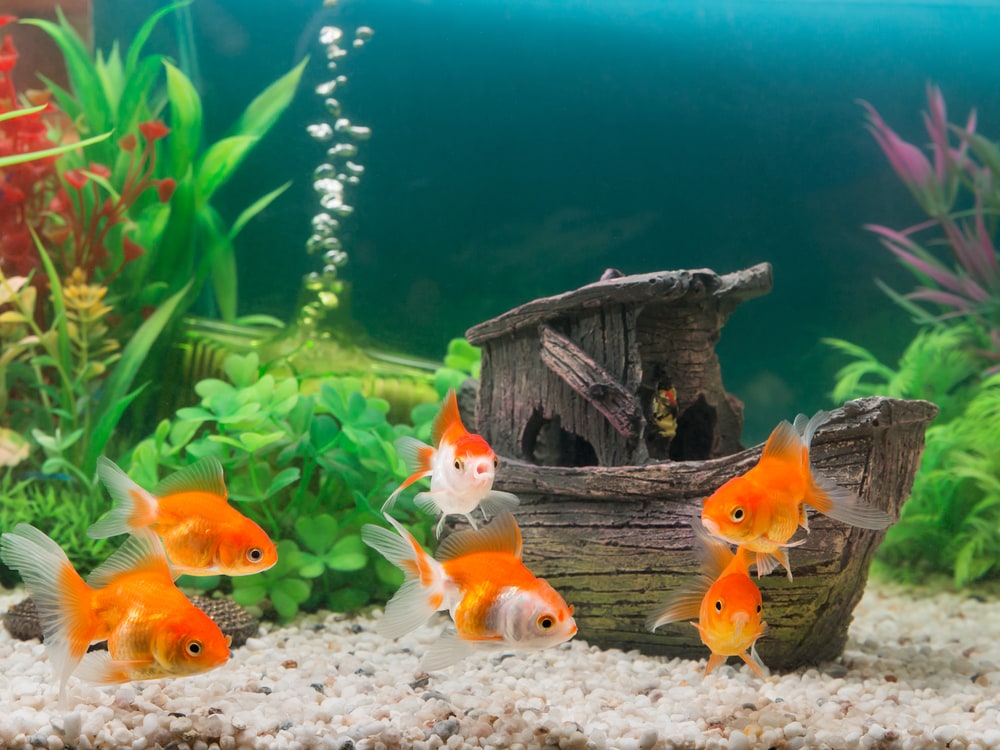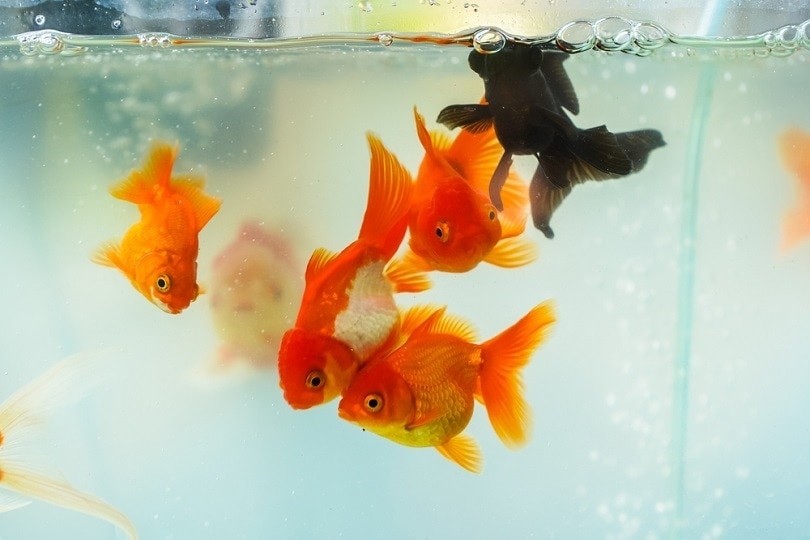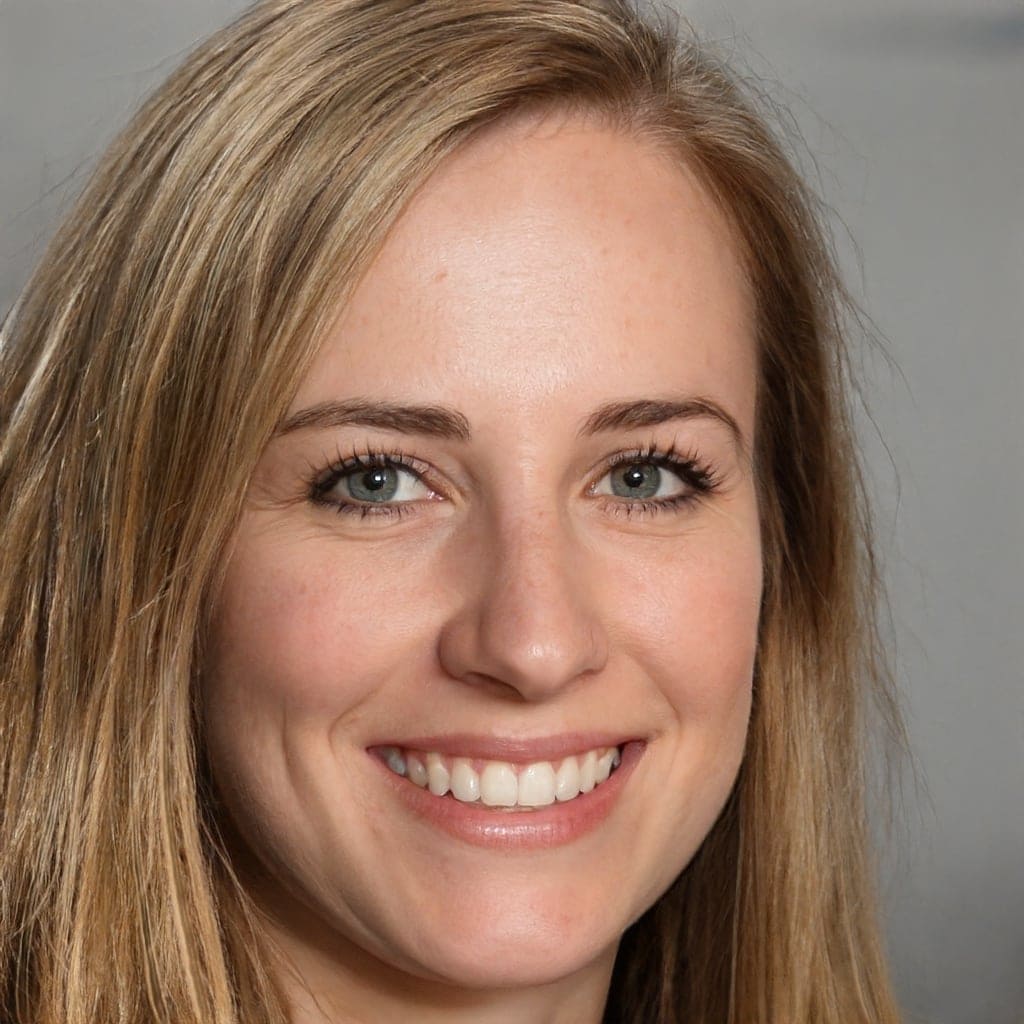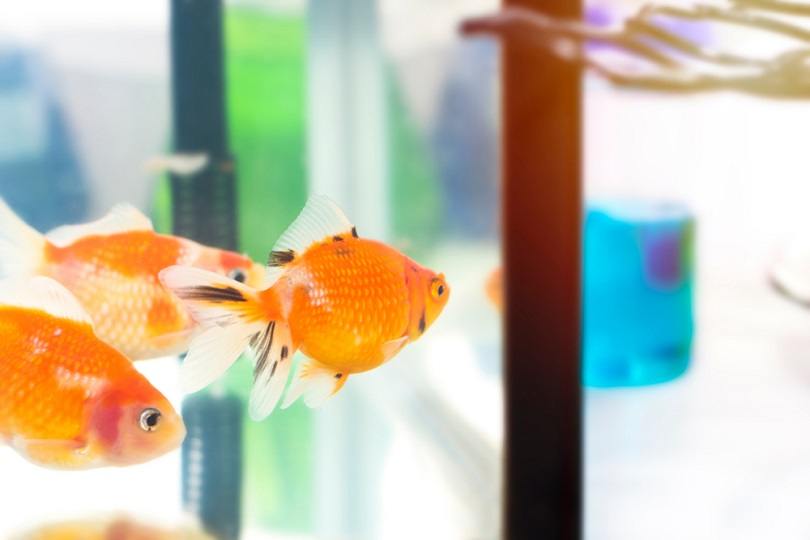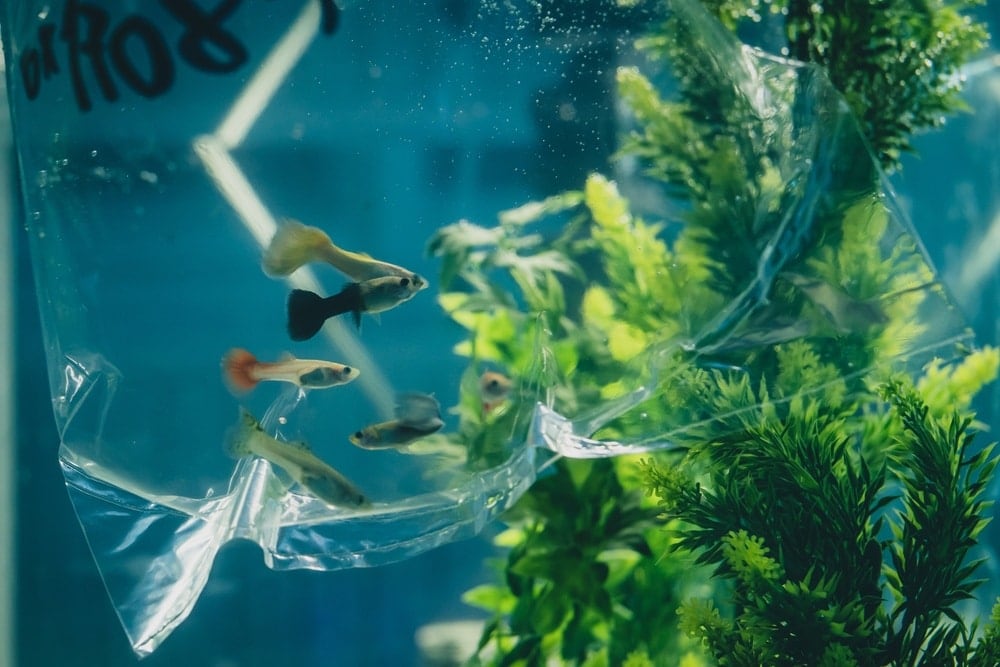How to Cycle Your Aquarium Using Liquid Ammonia – Our Vet Explains
By Dr. Luqman Javed, DVM (Vet)
Updated on
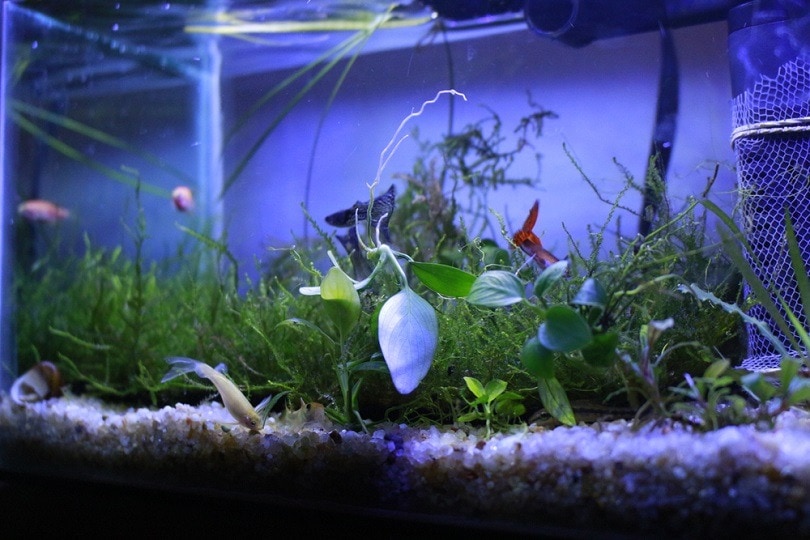
Click to Skip Ahead
One of the most critical elements every fish keeper must understand is how to cycle their tank. This is necessary in order to provide a stable environment for their aquatic community and prevent health issues that result from new tank syndrome, a serious and often fatal condition caused by unbalanced water parameters. Achieving stability in a tank’s ecosystem can only be done through the nitrogen cycle, a process which we will cover in detail in this article.
The Nitrogen Cycle
What Is It?
The nitrogen cycle is a naturally occurring process by which nitrogen is converted into different chemical forms. Before diving into cycling your aquarium, you might be curious as to why it is necessary to do so.
Ammonia (NH3) is a naturally occurring compound which contains nitrogen – denoted by the “N” in its chemical formula. Ammonia is very toxic for aquatic organisms (plants, fish, and aquatic invertebrates). The tolerance of ammonia varies by which species of fish you keep, but it is fair to say that incorrect levels of ammonia are toxic for any pet fish you plan to keep.

Interestingly, ammonia is also produced by fish as a byproduct of their regular metabolism. In nature, this isn’t much of an issue. Fish live in wide open spaces where toxins are heavily diluted. Rainfalls and melting snowcaps constantly replenish their water supplies, and fish have the opportunity to swim to better waters, if needed. Many naturally occurring plants also utilize sources of nitrogen as fertilizer. Most importantly, the soil contains trillions of naturally occurring nitrifying bacteria which are able to process ammonia and neutralize it.
The neutralization of ammonia is relatively simple. Beneficial bacteria convert ammonia into nitrite. Nitrite is also toxic for fish and aquatic life. However, the bacteria then convert nitrite to nitrates. Nitrates are relatively safe for fish.
In nature, this cycle perpetually repeats itself (the nitrates are further processed into nitrogen, the most common gas found in air, and so on).
Challenges For Fish Keepers
For a fishkeeper, the situation is somewhat different.
- Placing a fish in a brand new tank which contains a finite amount of space and no beneficial bacteria means that pet fish can quickly become poisoned from the ammonia they produce themselves.
This scenario often results in disaster and the rapid loss of pet fish via ammonia or nitrite poisoning. Because this happens in new aquariums, it is also known as New Tank Syndrome.
- With enough time, and a source of ammonia, beneficial bacteria can eventually colonize an aquarium and render it safe for your fish.
The History of Aquarium Cycling
In the old days of fish keeping, the source of ammonia was somewhat controversial. It was other fish. Particularly hardy fish species were chosen and placed in an aquarium, to essentially produce ammonia. Then, the fish keepers would wait for nature to “do its thing” and in a matter of weeks they would determine that there’s a “base colony” of beneficial bacteria which could then support the fish in the tank. Slowly, they would increase the bioload by adding in a few more fish. This could kickstart the cycle once again, and the bacteria would multiply to match the new bioload presented to them.
This process is practiced in some places of the world today as well.
- Many fish keepers are adamant that it isn’t ethical to subject any fish to intentional ammonia spikes, as no matter how hardy they are, they would suffer from its presence.
- The fish used for cycling might not be the fish someone would want to keep on a long term basis in the aquarium, and might not be compatible with other fish in the final stock.
- Though the fish selected for this method are hardy, unfortunately some of them perish throughout the process. They also often have shorter lifespans even if they survive the ordeal
- This process is slow, as bacteria will only grow to where they need to support the bioload of the tank, and the addition of new fish prompts a new “mini cycle” which is associated with potentially toxic spikes of ammonia and nitrite as well.
For these reasons, cycling with fish has largely fallen out of favor. With liquid ammonia now being readily available, it is possible to cycle an aquarium without adding in any fish and subjecting them to unwanted toxins and stress. This process is known as a “Fishless Cycle” and is the accepted norm of the pet fish industry today.
What You Will Need for Cycling
Before you cycle your aquarium, you’ll need to make sure that you have everything ready.
To assist in the process, you can purchase or utilize the following as well:
- Beneficial cycling bacteria (optional, these can speed up the process)
- Additional water tests (pH, dH, dissolved oxygen, temperature)
If you are interested in purchasing beneficial bacteria, ensure the product you use contains the following strains of bacteria:
- Nitrosomonas or Nitrosococcus – these metabolize ammonia effectively
- Nitrobacter – these metabolize nitrite effectively
The Fishless Cycle – A Step By Step Guide
1. Set Your Tank Up
Set your tank up to where you would like to keep it when it’s full of fish. Please be mindful that because 1 gallon (3.8 L) of water weighs 8.3 lb (3.8 kg), even a small aquarium can be extremely heavy relative to its size. You should place your tank where you envision it will be when it’s housing your fish.
Calculate your aquarium’s maximum volume if you haven’t already done so. Add your substrate and ornaments in, and fill your aquarium. Condition the water with a water conditioner. To finish, install your filter and a heater (if available) at anywhere between 77 and 86 °F (25 and 30 °C). This temperature range is ideal for the growth of nitrifying bacteria. Turn on the filter and ensure everything is working and that your tank isn’t leaking. Let your aquarium run for a day.
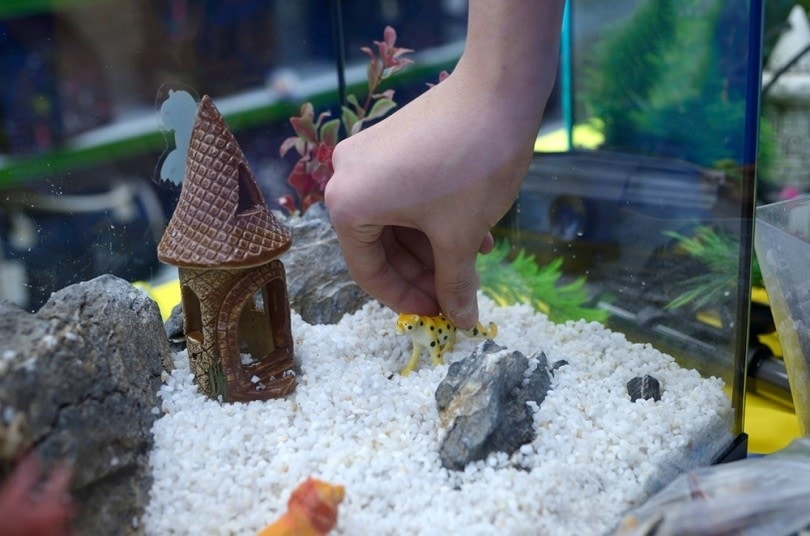
Important: Do not add any live plants to your aquarium at this point, as high levels of ammonia can harm plants.
2. Test Your Water
The next day, use the ammonia testing kit to test the ammonia in your tank. Most readings will be around zero, but depending on your water source and substrate, you may be able to pick up a low reading of around 0.2 (parts per million) ppm.
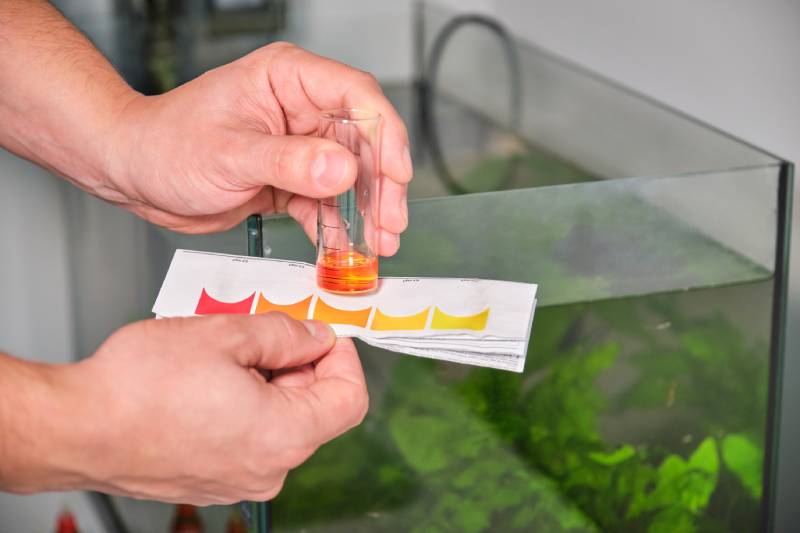
3. Add A Few Drops of Ammonia
Caution: Do not take a whiff of the ammonia when you open the bottle. Ammonia gas can be a respiratory irritant. Children should not be handling liquid ammonia.
Add a few drops (around 3 – 4) of your liquid ammonia into your tank’s water and wait for about a minute or so, to ensure that it has mixed with the water in your tank thoroughly. Make sure you keep count of how many drops you’ve added (it’s best to write this down).
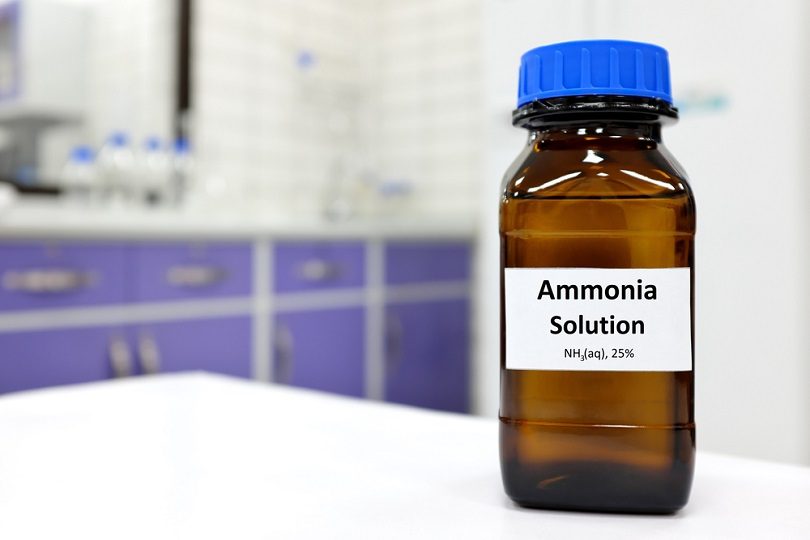
Optional: If you purchased bacteria to kick-start your cycle, now is the time to add them in.
4. Re-test Ammonia
Test your water again to determine the new ammonia level.
5. Repeat Steps 3 – 4
Repeat steps 3 to 4 until you get an ammonia reading of around 2 to 4 ppm. A reading of 2 ppm is ideal. A higher ammonia level (up to 4 ppm) is somewhat acceptable, but a rapid spike in ammonia may temporarily crash your aquarium cycle. Keep track of how many drops of ammonia you’ve added into your aquarium.

If you’ve obtained a reading of 2 ppm ammonia, record how many drops of ammonia were required to do so. This can make future calculations with the same product much easier and quicker, and will save you time.
6. Excess Ammonia Removal (Optional)
If you accidentally dosed ammonia to over 4 ppm, it’s best to do a partial water change to dilute it. Take note that the nitrifying bacteria cycle will progress much slower at 4 ppm ammonia. At 5 ppm ammonia, ammonia is lethal to these bacteria and the cycle will crash.
7. Maintain Ammonia Levels
Maintain ammonia levels at 2 ppm by checking your water every 2-3 days. If it ever drops below 2 ppm, use your calculations from before to adjust the ammonia levels back to 2 ppm.
For example:
- Say you have a 10 gallon aquarium which required 4 drops of your ammonia product to reach 2 ppm ammonia
- If this value drops to 1 ppm ammonia, you need to dose 2 drops of ammonia to bring it back to the required amount.
As you add drops to maintain ammonia levels in your aquarium, it is okay if you accidentally end up with a reading over 2 ppm, but it’s best to try and stay as close to 2 ppm as possible. You should remove excess ammonia at 5 ppm or above (as explained in step 6). It’s also best to measure ammonia at around the same time each day. It is wise to keep a journal to easily track your measurements throughout the process of cycling a tank.
8. Test For Nitrite
Begin testing for Nitrite when the ammonia levels begin to drop in your aquarium. This usually happens around 1 week after the initial cycle is started. It may happen sooner if you added in beneficial bacteria to kick-start your cycle. Remember that it is normal for ammonia levels to drop. As healthy bacteria populations grow, they will drop faster.
9. Maintain The Cycle
Always keep ammonia levels in your aquarium at around 2 ppm, and continue to test for both ammonia and nitrite every 2 to 3 days. After a few weeks, you’ll realize that your nitrite levels might begin to spike, while your ammonia levels fall rapidly. This indicates that there are plenty of ammonia neutralizing bacteria in your aquarium filter, and the nitrite neutralizing bacteria are starting to bloom.
Continue this process until you begin to detect Nitrates in your aquarium. This usually happens around the 4 week mark.
10. Reduce Ammonia & Monitor
Cut the dose of ammonia in your aquarium to around ¼ your initial dose once you begin to detect nitrates in your aquarium. This is done to actually stop the cycle. At this point, you will notice that both ammonia and nitrite quickly return to zero after you’ve added them in, but your nitrates continue to rise. Continue adding ¼ of the initial ammonia dosage until the bacteria are strong enough to bring the next reading to 0 ppm within 24 hours.
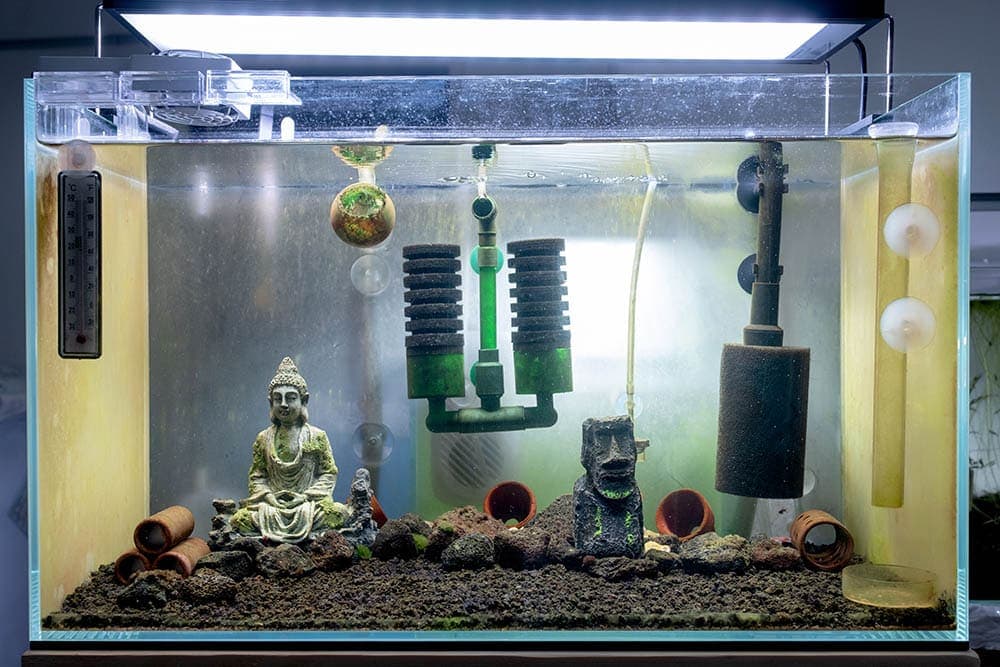
Important: Do not stop feeding your bacteria ammonia or they will die off and the cycle might preemptively crash!
11. Test Before Adding Fish
To see if your tank is truly ready for fish, add enough ammonia into your tank in the evening to cause a 2 ppm spike. The next morning, check the ammonia, nitrite, and nitrate levels. They should be as follows:
- Ammonia: 0 ppm
- Nitrite: 0 ppm
- Nitrates: should be present
This indicates that your tank is ready for fish. You may now add fish to your aquarium (within 24 hours). If your fish won’t be available within 24 hours, maintain the cycle until they can be collected.
12. Large Water Change
Nitrates, though relatively safe, can be detrimental to fish in high amounts. Therefore, you should do one large (50%) water change before adding your fish into your aquarium. Ensure your Nitrates are below 10 ppm before adding fish in.
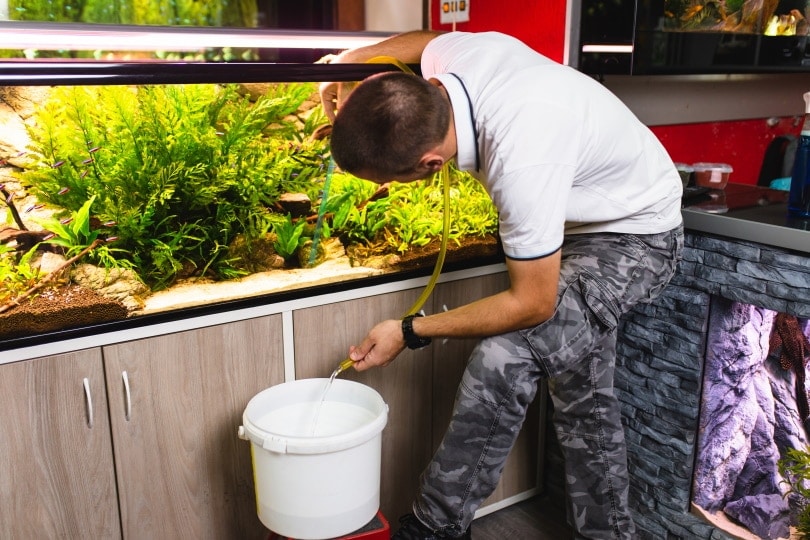
13. Acclimate and Add Fish
With the cycle being over, you can now acclimate and add your fish into the aquarium. The tank is also safe for aquatic plants now.
Frequently Asked Questions
Can I Add All My Fish At Once After a Fishless Cycle?
Yes! In fact this is the recommendation, as your fishless cycle produces a massive amount of beneficial bacteria. Once you add your fish into your aquarium, the colony size will adjust to match the bioload of your aquarium and some of these bacteria will naturally die off. However, adding just a few fish will result in most of your bacteria dying off unnecessarily. Adding all your fish at once is one of the great perks of a fishless cycle.
Can I Cycle My Aquarium With Higher Levels of Ammonia?
This is possible and recommended for tanks that you plan to stock exceptionally heavily. In addition, this cycle often takes longer. Ammonia levels of around 3 – 4 ppm are acceptable for such a cycle. Most reasonably stocked aquariums don’t require this though. As mentioned before, ensure ammonia levels do not exceed 5 ppm, as this is toxic even for the nitrifying bacteria.
Are There Ways To Speed Up The Process?
There are two ways this process can be sped up:
- Add beneficial bacteria to the aquarium while cycling the tank
- Use the bio media from an established, disease-free aquarium. In the simplest sense, this transfers a colony of bacteria from one aquarium to another. However, you should still test the water with ammonia before adding your fish in, as the bacteria might not be able to cope with a sudden change. This is also risky if the aquarium has any pathogens or diseases, as you might inadvertently transfer them to your new aquarium! This will also disrupt the cycle of the aquarium you take the media from
Why Is My Water Cloudy During The Process?
This is completely normal and a sign of a bacterial bloom. An initial bacterial growth spike leads to water that looks somewhat cloudy. This resolves by itself, as the bacteria eventually migrate onto surfaces and within your aquarium’s filter (they do not free-float in the water).
Are There Other Sources of Ammonia?
Fish food can be added to an aquarium to cause an ammonia spike, but it is generally not recommended because it takes time to achieve this effect, and also rots away in your aquarium. The food may also discolor the water and give rise to unwanted algae blooms. It’s also difficult to measure how much food is needed for a certain amount of ammonia spike to occur. As explained earlier, using live fish as a source of ammonia is considered unethical and unnecessary.
Conclusion
Understanding the fundamentals of the nitrogen cycle is mandatory for anyone who wishes to keep pet fish. In this article, we’ve explained how ammonia can be utilized to do an efficient, humane, and effective nitrogen cycle at home prior to purchasing your fish. The safe levels of beneficial nitrifying bacteria in your aquarium will ensure that your fish do not succumb to New Tank Syndrome and offer you years of joy as a fish keeper.
Featured Image Credit: Suyuthiahmad, Shutterstock



